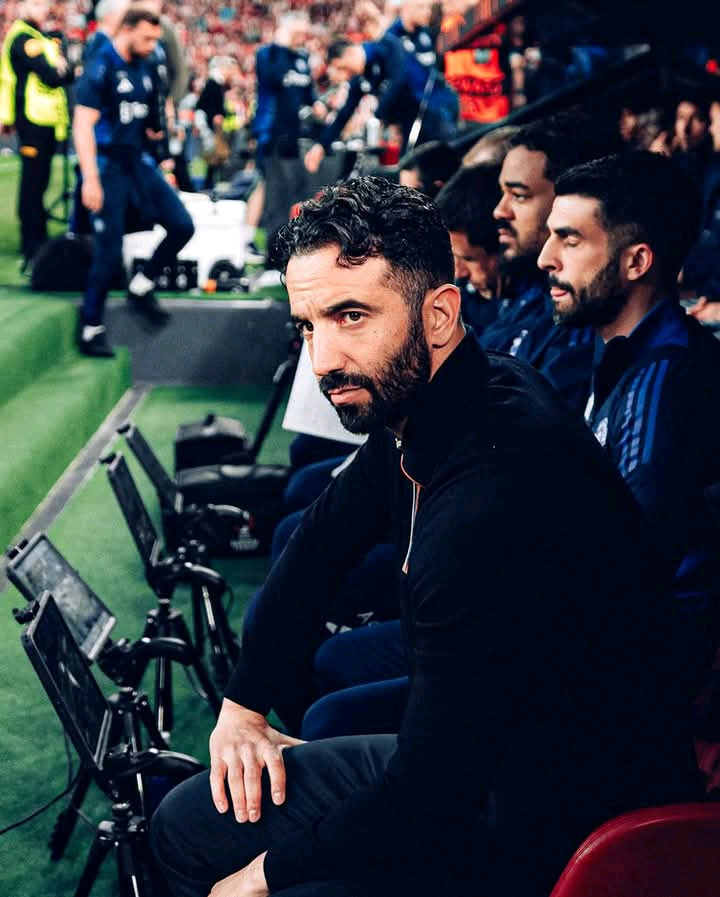Manchester United fans are scratching their heads. How can the same team that looks sharp, disciplined, and dangerous in the Europa League appear clueless and chaotic in the Premier League? The answer lies in the contrasting tactical approaches and how Reuben Amorim, the mid-season managerial replacement for Erik ten Hag, has chosen to adapt or not adapt his strategies across competitions.
The Ten Hag Blueprint Still Lives in Europe:
Reuben Amorim didn’t walk into a blank slate. He inherited a system meticulously constructed by Ten Hag, one based on reactive football, not possession dominance. The squad is largely made up of Ten Hag’s signings, players conditioned to thrive in low-block, mid-press environments with an emphasis on vertical transitions. Picture a 4-2-3-1 morphing into a 4-4-2 when out of possession. That’s the setup, and Amorim has leaned into it for European fixtures.
Rather than immediately forcing his preferred 3-4-3 or positional 4-3-3, Amorim opted for familiarity in Europe. He retained the system’s defensive solidity and transition-based structure. United often sit in a compact 4-4-2 when out of possession, with Casemiro and Ugarte controlling the central lanes, forcing opponents wide, and maintaining vertical compactness.
In attack, it’s direct and purposeful. Bruno Fernandes receives early balls in the half-spaces. Garnacho holds width, stretching the field, while fullbacks remain conservative to limit transitional exposure. Bruno and Garnacho act as the primary transition triggers, launching counters the moment possession is regained. The first pass is almost always vertical or diagonal, often prompting fans to scream at Onana, who is simply following orders.
This shape has worked wonders in Europe. United have become harder to break down, deadlier in counters, and tighter in central areas. The expected goals against (xGA) stat consistently drops in these games, proving the system’s effectiveness in continental competition.
But the EPL Is a Different Beast:
Domestically, however, Amorim reverts to his preferred attacking 3-4-3 or a hybrid 3-2-5 in possession. It’s a brave approach. Wingbacks push high, the midfield pivots rotate wide, and Bruno drops into zone 14 to dictate play. But the Premier League punishes bravery without balance.
EPL sides are tactically sharp and physically ruthless. They exploit the space behind the wingbacks. The back three gets overloaded. Casemiro, not the most mobile at this stage of his career, is left exposed when pressing forward. Recovery runs are slow. And once the ball is lost, United’s structure collapses. Possession becomes sterile. Build-ups lack rhythm. Turnovers become self-inflicted wounds.
This was evident in their loss to Tottenham earlier this season. Spurs, under Ange Postecoglou, used their high line, vertical pressing, and wide overloads to strangle United between the lines. Their narrow front three and inverted fullbacks overloaded United’s midfield, exposing the lack of compactness and tactical discipline.
The Final vs Spurs: A Tactical Crossroads:
As the final against Spurs looms, Amorim finds himself at a crossroads. Does he return to the conservative 4-4-2 that’s worked in Europe, or stick with his aggressive 3-4-3 that has yet to yield results in the EPL? The risk-reward calculus is tricky.
There is a potential middle ground, a 4-3-2-1 “Christmas tree” formation. We’ve seen glimpses of it already, with Casemiro anchoring, Ugarte and Mount shuttling, and Bruno/Garnacho operating behind Højlund. It’s more compact, offers layered pressing, and limits central exposure. It might just be the compromise United needs to handle Spurs’ midfield intensity and pressing traps.
Still, Amorim’s tactical maturity will be tested, not just in shaping a winning strategy, but in reacting to the tempo, transitions, and tactical intelligence that define English football.
Europe Suits United For Now:
The truth is, Manchester United currently look better in Europe not because they are dominating games, but because European football’s rhythm suits the structure Ten Hag ingrained and Amorim has wisely continued. The team functions better when asked to defend first, counter later, and avoid expansive build-up play.
Unless the squad evolves both tactically and structurally, United will continue to struggle in a domestic league that requires more than just familiarity. Against a well-drilled Spurs side, anything less than a tactical miracle might not be enough.
Prediction? If United play the way they’ve been playing in the league, the final is Tottenham’s to lose.
Should we send you latest update about your favourite sports and team?
Enter you email in the box below and hit the subscribe button to join our teaming 876+ sports community.
